An Overview
A New Beginning
You might not expect the world of primary school teacher training to offer up a worthy story of challenge, adventure – even revolution – among the annals of Western Australia’s ever-lengthening post-colonial history. Yet it did do just that! And this necessary revolution did not begin in the State Education Department until twenty-five years after the ending of World War II and nearly 70 years since the first teachers’ college was set up in this state. The way we prepared young school-leavers to go out into the schools of this vast state as trusted teachers from then underwent a total overhaul. For those who took part in the changes, as the college managers, as the lecturers or as the student teachers themselves, these were indeed exciting times.
For once there would be funds aplenty, resulting from Federal Government intervention in this area, thus creating a clean slate for re-conceptualising the physical form of buildings and services and new concepts of teacher education, largely emanating from innovative American educational psychology and democratic philosophies. This is the story of one particular institutional response to a need for new approaches, new ideas and new training methods. This resulted in the new tertiary colleges preparing a new brand of teacher in an era of rapid change. A more detailed account of these changes will follow later in a series of comprehensive chapters. Meanwhile, this brief introduction to the evolution of the Mount Lawley Campus is intended to provide both prelude and a preliminary overview.
Following the Second World War, the State of Western Australia (roughly a third of the size of USA or China) had an enhanced awareness of its strategic significance and its substantial agricultural and mining potential. Together with major post-war immigration, this potential would be realized but as an enormous challenge in providing resources for the population growth to come.
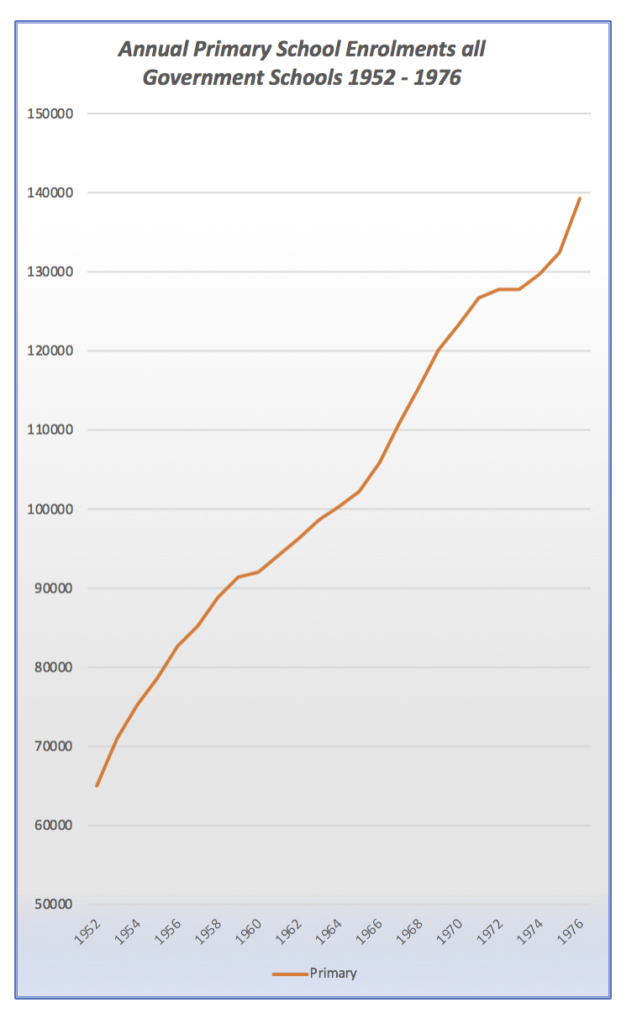
One vital service would be the growing number of primary schools— not only for the dispersed country towns but also for those in the Perth Metropolitan area, with its industrial and dormitory suburbs. Perth had a pre-war population of only some 250,000 persons, but soon that would double and triple and keep on growing faster and faster. And consequently, there was a rapid increase in primary school enrolments as indicated in Figure 1. To find and train enough teachers for the schools needed far and wide was not a prospect for faint-hearted planners.
It seems strange that just the second new primary teachers training college to be built in Western Australia in the twentieth century was opened 68 years after the first. Claremont Teachers’ College in 1902. The next purpose-built college for primary teachers was not constructed until 1970, at Mount Lawley just north of Perth City.

In the interim, as an adjunct to Claremont College, the Graylands Teachers’ College operated ‘temporarily’. This was set up in 1955 in a post-World War II Migrant Camp in Claremont’s. nearby suburb of Graylands and was continued until almost 1980. Meanwhile, by 1967, the first secondary teachers’ college had opened in Stirling Highway Nedlands, adjacent to the University of WA. The majority of students of this new Nedlands Secondary Teachers’ College also were enrolled in degree courses at the University of WA.
Graylands College eventually was closed in 1979, mainly because from 1972, yet another new teachers’ college in Churchlands had begun servicing the growing western and northern suburbs. In 1982, along with Claremont and all these newer teachers colleges, Churchlands too became part of a consortium, the ‘WA College of Advanced Education’. Churchlands itself was finally closed in 1990 and by 1987 another new and much larger college of WACAE—the Joondalup Campus—had been inaugurated.
Planning for the new Mount Lawley college took place at a time when countries across the globe were questioning the quality of education at primary, secondary and tertiary levels. They were considering the educational content of school programs, the efficiency of the teaching methods and in particular the content and quality of teacher education. Likewise, in Australia, several committees of inquiry at state and federal level were established to investigate the content, quality, needs and resources of educational programs at all levels of learning, and in particular at secondary and tertiary levels.
Parallel to these inquiries, major advances in educational psychology and in the design of instruction and student learning were changing the content, mode of delivery and learning programs in the USA, UK and Europe. These influences had a major impact in the planning for the new Mount Lawley college, particularly on the design of buildings, the introduction of a range of educational technologies and, in particular, the establishment of an integrated multimedia centre.
Education under the microscope – New Directions
In Australia, there was a rapid rise in population growth after WWII, through natural growth after the post war baby boom and a determined focus on immigration to bring in substantial numbers of workers for the massive new infrastructure projects. Consequently, by 1960 these ‘baby boomers’ were passing through primary schools and into secondary schools, thus putting increased pressure on existing schools and available teaching staff.
This influx of students, particularly in W.A. secondary schools, was anticipated as early as 1952 in the first Committee of Inquiry Report, but very little was done to implement their recommendations. Subsequently, several committees of inquiry were instituted by state and federal governments resulting in significant changes in funding these governments for education at primary, secondary and tertiary level.
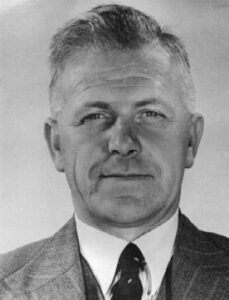
With particular relevance to the planning and design of the new Mount Lawley Teachers College two major reports stand out as significant. The Martin Report “The future of tertiary education in Australia” (1964) established by the Federal Government, which focused on all aspects of tertiary education and saw ‘education as an investment’ “yielding direct and significant economic benefits by upgrading skills and accelerating technological progress”.
The Report also emphasised that: “It is clear that, in order to cope with the increasing school population and to reduce classes to a reasonable size, Australia already needs many more teachers, and this need will continue to increase in the future”.
In particular, the Committee recognised that: “It is in the training of teachers for primary schools that this need is most apparent.
The Committee further indicated that:
a course of two years’ duration affords inadequate opportunities for preparation for a calling which, in primary as well as secondary schools, is making increasing demands upon the professional competence of teachers. The Committee believes that the extension of the course of training for primary school teachers to three years is not only highly desirable but, given the facilities and the will, is an objective which could be attained over a period of some six or seven years.
The Committee is convinced that both the increase in the supply of teachers and the improvement in the quality of their professional preparation are matters of urgency in the interests not only of the schools concerned but of the whole of the nation’s educational structure.
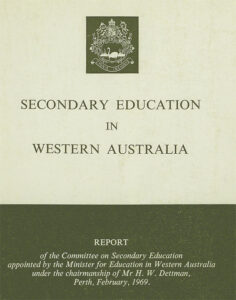
In Western Australia, the Dettman Report (1967) also focused on secondary education and it envisaged:
considerable changes in the role of the teacher. He should become less a dispenser of information and more a person who structures learning situations and guides learning activities. He is likely to be able to specialize more in relation to the subjects which he will be required to teach, but will need to have a better understanding of the nature of adolescence and the process of learning.
Despite these changes, the success of any educational program will continue to depend largely on the contribution made by teachers. Hence we believe that the implications of this report for the pre-service and in-service education of teachers should be investigated by the responsible authorities.
The report emphasised that:
The provision of adequate resources helps teachers carry out their duties more effectively. These resources include buildings and facilities, instructional materials and educational technology.
Thus, the reports encouraged greater attention to the training of teachers, increasing their number, lengthening the courses from two to three years, areas of specialisation, and adequate provision of resources for buildings, facilities, instructional materials and educational technology. All of these were a major influence on the planning and design of Mount Lawley Teachers College.
Initially learning focused on the work of Ivan Pavlov (early 1900’s), whose theories of classical conditioning, suggested that two stimuli had to be paired for learning to take place. However, this was of little importance to teaching children how to learn. There was no emphasis on motivation, and it did not lead to instructional techniques on how to teach in the classroom.
From the late thirties onwards, psychologists began to explore the the conditions for learning and nature of the learning process. There was an emerging need to develop a branch of educational psychology with a focus on learning and teaching, as objectives indicated what learners were expected to know, understand, interpret, explain, and demonstrate at the completion of the learning process. The learning objectives were grounded on an increasing level of competence, based on the Bloom’s (1965) Taxonomy of Educational Objectives. This followed a hierarchical development from knowledge, comprehension, application, analysis, synthesis to evaluation.
Piaget’s Theory of cognitive development (1936) had a specific focus on how children learn and develop their cognitive structures, along with BF Skinner’s work on operant conditioning. This an emphasised a stimulus, a response and the reinforcing consequences. It was based on rewards and punishments for behaviour, building an association between behaviour and its consequences. Thus there was the beginning of a theory of learning. When students are motivated and presented with material in small steps and with their active participation in the learning process, they can receive immediate feedback as to success of failure of the learning task. This process can be applied to the learning of cognitive as well as psychomotor skills. It resulted in the development of the early learning “machines” which also allowed the learners to move through material at their own pace.
The major breakthroughs in the development of theories of learning and associated models of teaching strategies came in the 1960s. Jerome Bruner (The process of education, 1960 and Toward a theory of instruction, 1966) focused on students as active participants in the learning situation where they constructed their own knowledge. It is Bruner’s conviction “that any subject can be taught effectively in some intellectually honest form to any child at any stage of development”.
To achieve this, he introduced the concept of a spiral curriculum where complex ideas can be broken down into simpler structures and taught at the appropriate age level. Subsequently the learning content can gradually be increased in difficulty level, and be taught at more complex levels at later stages in the child’s development. Thus the notion of a spiral curriculum where complex tasks are simplified at different levels lead to the process of discovery learning.
Discovery learning and task analysis became an integral part of the instructional processes designed for the planned new Mount Lawley Teachers College. To assist students in the development of their teaching skills, the principal of the new college insisted that all lecturers construct their teaching programs and content on specific learning objectives. These objectives should indicate what learners are expected to know, understand, interpret, explain, and demonstrate at the completion of the learning process. The learning objectives should follow an increasing level of competence, based on the Bloom’s (1965) Taxonomy of Educational Objectives which follow a hierarchical development from knowledge, comprehension, application, analysis, synthesis to evaluation.
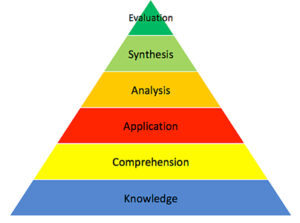
In addition the rapid advancements in technology, such as TV, computers, calculators, teaching machines, movie projections, overhead projectors and classroom/teaching designs posed an exciting prospect in the planning and design of a new college.
The College also emphasised the importance of cooperative small group learning where students work in small groups toward a common task, the use of multi-media to encourage individual student learning as well as a significant focus on interactive tutorial groups. With the emphasis on the rise of instructional design for classroom learning, it it not surprising that Robert Gagné (1965) Conditions of learning became the set text for all students in their second year in educational psychology at Mount Lawley College.
Gagné focused on three major components in the learning process: a) a taxonomy of learning outcomes, b) specific learning conditions to attain those outcomes, and c) nine events of instruction. He considered five types of outcomes: verbal information (corresponding to Bloom’s knowledge and understanding), Intellectual skills (application, analysis, synthesis, and evaluation), cognitive strategies, attitudes, and motor skills. He proposed a process of task analysis to identify the prerequisites for the learning or training task to facilitate the achievement of the stated objectives.
To achieve the outcomes, Gagné suggested the nine events of instruction: gaining attention (reception), informing learners of the objectives (expectancy), stimulation recall of prior learning (retrieval), presenting the stimulus (selective perception), providing learning guidance (semantic coding), eliciting performance (responding), providing feedback (reinforcement), assessing performance (retrieval), and enhancing retention and transfer (generalization).
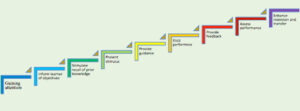
With a major in psychology and extensive experience in teacher education, the inaugural principal of the proposed new Mount Lawley Teachers College encouraged the planning staff in adopting the latest developments in educational psychology, instructional design, open plan learning, student active participation in the learning process, small group learning and the advancement in educational technology to plan, design and build a radically new college building.